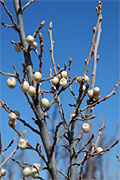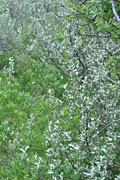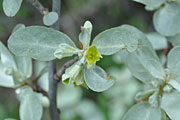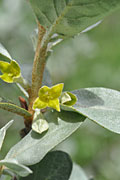« Back to your search
Species Details
Elaeagnus commutata Bernh. ex Rydb.
University of Alberta Vascular Plant Herbarium Read more about this collection »
LeavesAlternate; egg-shaped to lance-shaped; rippled appearance; width half of length; silver hairs both surfaces; underside may have rusty-brown scales (Moss, 1983). 1-5.5 cm long; 0.5-2.5 cm wide.
FlowersInflorescene a cyme, 2-5 flowered; bilaterally symmetric; sepals 4, fused into funnel-shape, enclosing the pistil, 1.2-1.5 cm long, yellow inside, silvery outside; petals absent; stamens 4; pistils 1, ovary superior
Fruits and Seeds0.6-1 cm long; elliptic shape; silver; dry and crumbly (Moss, 1983). One large nutlet; berry (Johnson et al., 1995).
Scientific Name
Elaeagnus commutata Bernh. ex Rydb.
Common Name
silverberry, wolf willow
General Description
A shrub that grows 1-4 m tall from rhizomes with twigs covered in rusty-brown scales, silver leaves, and bears silver berries on yellow-silver flowers (Johnson et al., 1995).
Leaves
Alternate; egg-shaped to lance-shaped; rippled appearance; width half of length; silver hairs both surfaces; underside may have rusty-brown scales (Moss, 1983). 1-5.5 cm long; 0.5-2.5 cm wide.
Flowers
Inflorescene a cyme, 2-5 flowered; bilaterally symmetric; sepals 4, fused into funnel-shape, enclosing the pistil, 1.2-1.5 cm long, yellow inside, silvery outside; petals absent; stamens 4; pistils 1, ovary superior
Inflorescene a cyme, 2-5 flowered; bilaterally symmetric; sepals 4, fused into funnel-shape, enclosing the pistil, 1.2-1.5 cm long, yellow inside, silvery outside; petals absent; stamens 4; pistils 1, ovary superior
Fruits and Seeds
0.6-1 cm long; elliptic shape; silver; dry and crumbly (Moss, 1983). One large nutlet; berry (Johnson et al., 1995).
Phenology
Flowers from June to July (Johnson et al., 1995).
Notes
2n=28 (Moss, 1983). The strong scent of the flower can be detected from a few meters away; this scent can also be detected when the wood is burned; immature green wood, if burned, smells like human excrement (Johnson et…
2n=28 (Moss, 1983). The strong scent of the flower can be detected from a few meters away; this scent can also be detected when the wood is burned; immature green wood, if burned, smells like human excrement (Johnson et al., 1995). While some groups considered it a famine food, the Cree and Blood mixed with blood, lard, or moose fat and ate (Johnson et al., 1995). The Cree also used the bark to make cord and the seeds as decorative beads (Johnson et al., 1995).
Similar species:
Elaeagnus angustifolia
E. angustifolia is an introduced and escaped ornamental tree. It can be distinguished from E. commutata by thorny branches, yellow flowers about 1 cm long, and yellow berries.
Range/Distribution
Alberta: predominantly southern half of the province (Canadensys). CAN (BC, MB, SK, NT, NU, ON, QC, YT); USA (WA, ID, MT, WY, UT, CO, ND, SD, TX, MN, KY, MD, NY, RI) (USDA).




Citation
Page Citation for Elaeagnus commutata Bernh. ex Rydb.
Page Citation
"Species Details - Elaeagnus commutata Bernh. ex Rydb., University of Alberta Vascular Plant Herbarium." University of Alberta Museums Search Site, https://search.museums.ualberta.ca/g/1-4641/12-103084. Accessed 03 Nov. 2024.
Specimen Information
There are 106 specimens of this Species.
142012 - Elaeagnus commutata Bernh. ex Rydb.
University of Alberta Vascular Plant Herbarium
Common Namesilverberry, wolf willow
Place CollectedNorth America: Canada, Alberta, Mattheis Research Ranch
Date Collected2018-06-06



